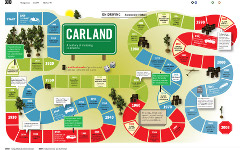Yesterday afternoon the Obama administration released a proposal for new CAFE standards of 35.5 miles per gallon by 2016, up from the current 27.5 MPG. Soon the average automobile may finally get significantly better mileage than the Model T. Still, under these regulations, cars sold on the American market in 2016 will consume use more gas than Chinese cars from 2005! It is worth noting though, that since Ford’s time vehicle safety has improved, and most drivers have ridiculous amounts of horsepower to spare.
The 250 grams per mile of carbon dioxide limit the proposal puts forth is not a restriction at all. This comes to 19.42 pounds per gallon for 35.5 MPG vehicles, the same quantity of emissions as the EPA currently reports for a gallon of gasoline. In other words, at its current value it is redundant, and simply another way of saying 35.5 MPG. However, this needn’t be the case if gasoline formulations were to change.
Lastly, here’s some coverage of events leading up to the announcement, and some interesting graphs of DOT and EIA fleet fuel economy; this is real-world MPG, and is therefore affected by driving practices, weather, etc.


With the price of oil still hovering around $70 dollars a barrel and reports coming in from CERA, IEA and other industry analysts that oil demand is expected to recover in 2010, it is very likely that the price of oil will be rising again in the near future. Requiring competitive CAFE standards with other major car producing countries seems like the smart thing to do. See the article on oil demand for more information: http://www.warmhomecoolplanet.org/2009/09/15/rebounding-oil-demand-and-push-for-tar-sands/.
We’ve seen years of CAFE standards, and people gravitated to trucks, because they were on a separate standard. We have to raise the cost of using fuel. Ideally fossil fuels would be taxed to keep them above a minimum price that keeps use down and makes it easier to justify alternative power sources. This would then have to be raised over time as the oil supply depletes.
Rather than choose to invest in developing technologies to permit the continued production of station wagon type models, manufacturers abandoned these lines. SUV’s were born due to a loophole in the regulations, through the application of a passenger (rather than cargo)-oriented body to a light-truck frame. This resulted in the vehicle falling under the laxer fuel efficiency standards meant for service vehicles. I think there is sufficient blame to be shared amongst poorly drafted regulations, and dodgy business practices.
The current administration’s proposed standard maintains this split, and does not seek to classify vehicles by intended use rather than construction, but the 30+ MPG target for light trucks is respectable. Admittedly though, I am concerned that manufacturers might seek to game the system by playing with the dimensions (footprint) of their models.